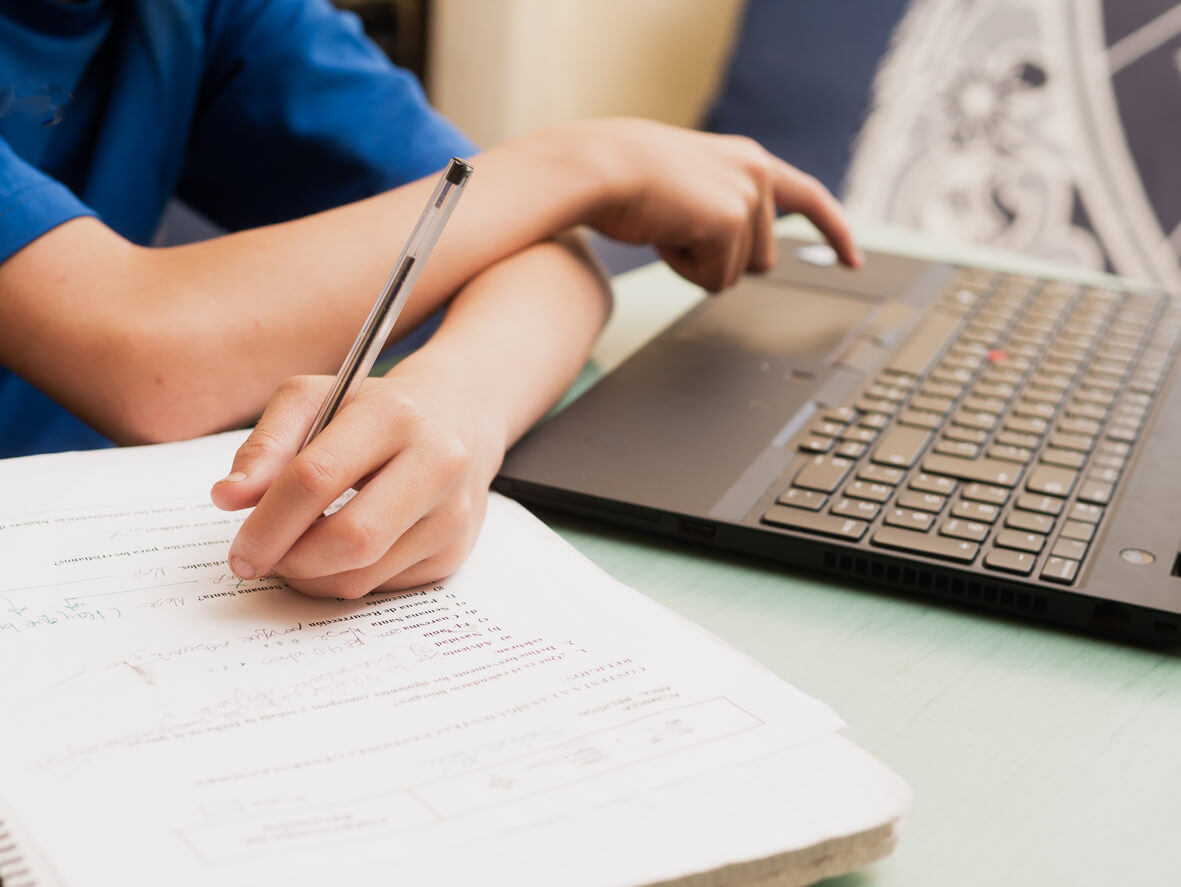5 Tips for Parents with Left-Handed Children


Reviewed and approved by the pediatrician Marcela Alejandra Caffulli
It’s important to learn what adults can do to facilitate the learning process for children who write with their left hand. For this reason, we’ll present 5 tips for parents with left-handed children that you can’t miss. You’ll see that it’s not complicated, it’s just a matter of being well-informed!
About 12% of people who are left-handed or have a problem with laterality often find it more difficult than usual to carry out certain tasks. This world seems to have been created for right-handers! Do you want to know what these difficulties are and what you can do to solve them easily and effectively? We’ll debunk some myths so you can teach your child the beauty of left-handedness.
Is being left-handed the same as having a problem with laterality?
To begin with, it’s important to differentiate between being left-handed and having a laterality problem. According to the Jöelle Guitart Center for Laterality and Psychomotricity, approximately 3% of people in the world are truly left-handed, although it’s true that this varies from country to country. In order to be able to determine this with rigor, it’s important to carry out a complete laterality test. In this regard, we can say that there are several types of left-handedness:
- Forced: This is the case of the person who, as a child, did things with their left hand and was forced to switch to the right. A method that, today, is considered detrimental.
- The pseudo-lefty: This is similar to the previous one, but the change occurred by imitation.
- Heterogeneous or crossed lateralization: For example, a person who’s right-handed with their hand (writes with the right hand), but is a lefty when it comes to their feet (they kick with their left foot).
- Ambidextrous: A person who uses both hands for functions that are normally performed with only one of them.
You’ll also be interested in: How to Know If Your Baby Is Right or Left-handed

5 tips for parents with left-handed children
Here are some tips for you to help make tasks easier for your left-handed child.
1. Exercise psychomotor skills
As well demonstrated in a research conducted in 2017 by several teachers from the Technical University of Machala, exercising psychomotor skills in Physical Education classes helps them to improve their spatial orientation and better define their laterality. However, keep in mind that this should be done during the early childhood education stage (before starting to write) and that a child’s laterality should never be corrected, as forcing them to use the opposite hand from the one determined by genetics can cause some of the following problems:
- Frustration
- Low self-esteem
- Problems with writing
- Difficulties in distinguishing right from left
- Dyslexia
- Stuttering
In addition, far from solving anything, they’ll become “a covert lefty”, and this won’t do them any good. It’s important to accept things as they are because there are many myths falsely spread against people who are left-handed, but the reality is that they were born that way due to genetic factors.
2- Teach them to sit in whatever way is more comfortable for them
It’s normal for some children to ask to sit at the corners of the table to avoid bumping into the person who eats with their right hand. So, respect their decision so that they’re as comfortable as possible. Also, if they prefer, reserve the left side of the table just for them. In this regard, it’s also important to pay attention to classroom chairs that have a table. These are usually designed for right-handers only. In class, if a classmate that sits by them uses their right hand, they should also sit on the left side so that both have greater mobility.
3. Help them hold their pencil and paper well
Left-handed children make better use of triangle-shaped pencils and pens. In addition, the position of the child’s hand when writing should be monitored and corrected. For example, using a pencil adapter can help the child adopt the correct grip.
Also, according to an article published in the Journal of Education, it’s important to talk to teachers to take this into account so that their learning is as fair as possible. Especially when it comes to writing and problems such as dysgraphia.
3. Guide them in mirror mode
As the Kulunka Association explains, many left-handed children are prone to writing in mirror mode. This is because their natural tendency is to go from right to left. This is why they can often get confused and write numbers or letters backward. The mirror mode consists of the fact that, if you’re left-handed parents, you will have to stand in front of them so that they can copy you more easily and improve their visual directional discrimination.
See: Specular Writing in Children: Characteristics and Causes

4. Provide left-handed tools
Although it may not seem like it, the truth is that providing school supplies to help your child manage freely and safely at school is a crucial factor in their development. The reality is that for left-handed children, working with right-handed tools will cause unnecessary frustration and discomfort. For this reason, there are different materials adapted for them, such as pens with a bent tip, scissors, rulers, pencil sharpeners, and notebooks, among others.
5. Be patient when something’s difficult for them and always support them
Support, patience, and understanding are three requirements that can’t be lacking when it comes to accompanying any child. Of course, these should be intensified when you see that your child is left-handed. It’s not a question of not being able to do things or doing things incorrectly. On the contrary, these are negative thoughts that surface when you yourself lose the above three qualities.
That’s why your child needs your support to develop to their full potential. Realize that today’s society is poorly made for people who only write with their right hand, despite the fact that, little by little, there’s more tolerance and materials created specifically for them.
Facing a right-handed world with these tips for parents with left-handed children
If you think your child may be left-handed, there are several ways to verify it, but specialists expressly mention the Oseretsky test. This is a neuropsychological evaluation performed professionally in a psychologist’s office and takes one, two, or even three sessions. In addition to evaluating laterality, it will detect processes that weren’t consolidated and that give rise to disturbances on an academic level.
At the same time, it also consists of a series of exercises where the child or adolescent has to define their preferences. In any case, the important thing is to go to a specialist and apply these 5 tips that we hope have been useful and of interest to you. We also hope they’ve helped you to understand a little more about the spectacular world of your child.
It’s important to learn what adults can do to facilitate the learning process for children who write with their left hand. For this reason, we’ll present 5 tips for parents with left-handed children that you can’t miss. You’ll see that it’s not complicated, it’s just a matter of being well-informed!
About 12% of people who are left-handed or have a problem with laterality often find it more difficult than usual to carry out certain tasks. This world seems to have been created for right-handers! Do you want to know what these difficulties are and what you can do to solve them easily and effectively? We’ll debunk some myths so you can teach your child the beauty of left-handedness.
Is being left-handed the same as having a problem with laterality?
To begin with, it’s important to differentiate between being left-handed and having a laterality problem. According to the Jöelle Guitart Center for Laterality and Psychomotricity, approximately 3% of people in the world are truly left-handed, although it’s true that this varies from country to country. In order to be able to determine this with rigor, it’s important to carry out a complete laterality test. In this regard, we can say that there are several types of left-handedness:
- Forced: This is the case of the person who, as a child, did things with their left hand and was forced to switch to the right. A method that, today, is considered detrimental.
- The pseudo-lefty: This is similar to the previous one, but the change occurred by imitation.
- Heterogeneous or crossed lateralization: For example, a person who’s right-handed with their hand (writes with the right hand), but is a lefty when it comes to their feet (they kick with their left foot).
- Ambidextrous: A person who uses both hands for functions that are normally performed with only one of them.
You’ll also be interested in: How to Know If Your Baby Is Right or Left-handed

5 tips for parents with left-handed children
Here are some tips for you to help make tasks easier for your left-handed child.
1. Exercise psychomotor skills
As well demonstrated in a research conducted in 2017 by several teachers from the Technical University of Machala, exercising psychomotor skills in Physical Education classes helps them to improve their spatial orientation and better define their laterality. However, keep in mind that this should be done during the early childhood education stage (before starting to write) and that a child’s laterality should never be corrected, as forcing them to use the opposite hand from the one determined by genetics can cause some of the following problems:
- Frustration
- Low self-esteem
- Problems with writing
- Difficulties in distinguishing right from left
- Dyslexia
- Stuttering
In addition, far from solving anything, they’ll become “a covert lefty”, and this won’t do them any good. It’s important to accept things as they are because there are many myths falsely spread against people who are left-handed, but the reality is that they were born that way due to genetic factors.
2- Teach them to sit in whatever way is more comfortable for them
It’s normal for some children to ask to sit at the corners of the table to avoid bumping into the person who eats with their right hand. So, respect their decision so that they’re as comfortable as possible. Also, if they prefer, reserve the left side of the table just for them. In this regard, it’s also important to pay attention to classroom chairs that have a table. These are usually designed for right-handers only. In class, if a classmate that sits by them uses their right hand, they should also sit on the left side so that both have greater mobility.
3. Help them hold their pencil and paper well
Left-handed children make better use of triangle-shaped pencils and pens. In addition, the position of the child’s hand when writing should be monitored and corrected. For example, using a pencil adapter can help the child adopt the correct grip.
Also, according to an article published in the Journal of Education, it’s important to talk to teachers to take this into account so that their learning is as fair as possible. Especially when it comes to writing and problems such as dysgraphia.
3. Guide them in mirror mode
As the Kulunka Association explains, many left-handed children are prone to writing in mirror mode. This is because their natural tendency is to go from right to left. This is why they can often get confused and write numbers or letters backward. The mirror mode consists of the fact that, if you’re left-handed parents, you will have to stand in front of them so that they can copy you more easily and improve their visual directional discrimination.
See: Specular Writing in Children: Characteristics and Causes

4. Provide left-handed tools
Although it may not seem like it, the truth is that providing school supplies to help your child manage freely and safely at school is a crucial factor in their development. The reality is that for left-handed children, working with right-handed tools will cause unnecessary frustration and discomfort. For this reason, there are different materials adapted for them, such as pens with a bent tip, scissors, rulers, pencil sharpeners, and notebooks, among others.
5. Be patient when something’s difficult for them and always support them
Support, patience, and understanding are three requirements that can’t be lacking when it comes to accompanying any child. Of course, these should be intensified when you see that your child is left-handed. It’s not a question of not being able to do things or doing things incorrectly. On the contrary, these are negative thoughts that surface when you yourself lose the above three qualities.
That’s why your child needs your support to develop to their full potential. Realize that today’s society is poorly made for people who only write with their right hand, despite the fact that, little by little, there’s more tolerance and materials created specifically for them.
Facing a right-handed world with these tips for parents with left-handed children
If you think your child may be left-handed, there are several ways to verify it, but specialists expressly mention the Oseretsky test. This is a neuropsychological evaluation performed professionally in a psychologist’s office and takes one, two, or even three sessions. In addition to evaluating laterality, it will detect processes that weren’t consolidated and that give rise to disturbances on an academic level.
At the same time, it also consists of a series of exercises where the child or adolescent has to define their preferences. In any case, the important thing is to go to a specialist and apply these 5 tips that we hope have been useful and of interest to you. We also hope they’ve helped you to understand a little more about the spectacular world of your child.
All cited sources were thoroughly reviewed by our team to ensure their quality, reliability, currency, and validity. The bibliography of this article was considered reliable and of academic or scientific accuracy.
- Asociación Kulunka. Consejos para niños zurdos [Internet]. Kulunka.org. [citado 7 de septiembre de 2021]. Disponible en: https://kulunka.org/wp-content/uploads/2013/12/doc_12.pdf
- 21. Luque A. Consejos para criar a un niño zurdo [Internet]. Webconsultas.com. Webconsultas Healthcare; 2016 [citado 7 de septiembre de 2021]. Disponible en: https://www.webconsultas.com/bebes-y-ninos/educacion-infantil/consejos-para-criar-a-un-nino-zurdo
- Ollé Riba F. La educación de los niños zurdos. Rev educ [Internet]. 1958 [citado 7 de septiembre de 2021]; Disponible en: https://redined.educacion.gob.es/xmlui/handle/11162/82721
- Pi MCM. Relación entre la lateralidad [Internet]. Udl.cat. [citado 7 de septiembre de 2021]. Disponible en: https://repositori.udl.cat/bitstream/handle/10459.1/46410/015510.pdf?sequence=1&isAllowed=y
- Moreno M. Los problemas a los que se enfrentan los niños zurdos [Internet]. SerPadres.es. 2021 [citado 7 de septiembre de 2021]. Disponible en: https://www.serpadres.es/3-6-anos/educacion-desarrollo/fotos/problemas-de-ninos-zurdos-para-padres-diestros-611597055111
- Salvatierra N. Zurdos.cl ——– Educando niños Zurdos [Internet]. Zurdos.cl. [citado 7 de septiembre de 2021]. Disponible en: https://www.zurdos.cl/educando.html
- Tepán Gómez DA, Zhingri Matute DL. La lateralidad zurda asociada a dificultades en el aprendizaje escolar en niños de 6 a 7 años. 2010.
This text is provided for informational purposes only and does not replace consultation with a professional. If in doubt, consult your specialist.








